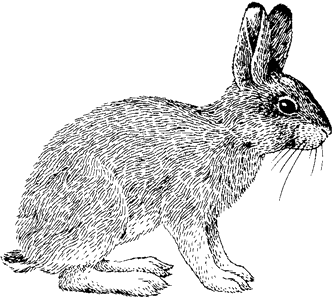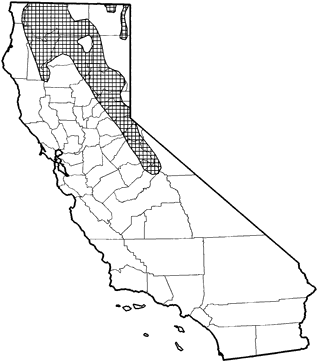
Snowshoe Hare
Distribution, Abundance, and Seasonality
An uncommon resident at upper elevations in the Cascade Mts. in Siskiyou and Del Norte cos. south through the Sierra Nevada to Mariposa, Mono, and Madera cos. A small, insular population also has been reported in the Warner Mts., Modoc Co. In California, primarily found in montane riparian habitats with thickets of alders and willows, and in stands of young conifers interspersed with chaparral. The early seral stages of mixed conifer, subalpine conifer, red fir, Jeffrey pine, lodgepole pine, and aspen are likely habitats, primarily along edges, and especially near meadows (Orr 1940, Ingles 1965). Abundance is highly cyclic in parts of range, and may be in California as well, but there is little evidence.

Range Map
Specific Habitat Requirements
Feeding: Grazes and browses. Summer food primarily consists of grasses, forbs, sedges, and low shrubs. Needles and bark of conifers, and leaves and green twigs of willow and alder, are eaten in the winter (Wolff 1980). Pease et al. (1979) suggested that winter browse availability serves as population control.
Cover: Dense cover is preferred, either in understory thickets of montane riparian habitats, or in shrubby understories of young conifer habitats. A shallow bowl-like depression (form) is made in dense understory or brush piles.
Reproduction: It is likely that no definite nests are built (Orr 1937), but grass, fur, or needles may line a shallow form placed under a shrub, log, or in slash.
Water: No data found.
Pattern: Prefers edges, heterogeneous habitats, and areas with dense understory, particularly in riparian habitats. Also found in areas with young firs with branches drooping to ground, and in patches of ceanothus and manzanita within, or bordering, fir or pine forests. Rarely found in open spaces or mature closed canopy forests (Conroy et al. 1979).
Species Life History
Activity Patterns: Activity primarily is crepuscular and nocturnal.
Seasonal Movements / Migration: In Alaska, tends to move from winter to summer ranges in response to availability of food and cover (Wolff 1980). There are no data regarding similar movements in California.
Home Range: In Colorado, Dolbeer and Clark (1975) found home ranges to average 8 ha (20 ac). O'Farrell (1965) found home ranges averaging 5.9 ha (15 ac) in Alaska.
Territory: May equal home range. Males are generally intolerant of each other, particularly during breeding season, and fights are frequent.
Reproduction: Breeds mid-February to June or July. The gestation period is 35-37 days. Litter size varies from 1-7, with about around 3. Polyestrous, with 2-3 litters per yr. Young breed in second yr (Asdell 1964).
Niche: Bobcats are the main predators of snowshoe hares in Oregon, followed by minks, weasels, foxes, coyotes, great horned owls, and domestic dogs and cats. Todd et al. (1981) suggested that coyotes may capitalize on high populations even though in normal years snowshoe hares are not a significant part of the diet.
Comments: Two subspecies are found in California. Both are California Species of Special Concern (Williams 1986). L. a. klamathensis is found in vicinity of Mt. Shasta, the Trinity Mts. and possibly the Warner Mts.; L. a tahoensis is found in the Sierra Nevada. Numbers of both subspecies, but particularly L. a. klamathensis are unknown, and may be quite low (especially in Warner Mts.). Also called snowshoe rabbit and varying hare.
Sources & References
California Department of Fish and Game, 1999.
California's Wildlife, Sacramento, CA.
Written by: G. Hoefler, R. Duke, reviewed by: H. Shellhammer, edited by: S. Granholm
Asdell, S. A. 1964. Patterns of mammalian reproduction. 2nd ed. Cornell Univ. Press, Ithaca, Ny. 670pp. Conroy, M. J., L. W. Gysel, and G. R. Dudderar. 1979. Habitat components of clear-cut areas for snowshoe hares in Michigan. J. Wildl. Manage. 43:680-690. Dolbeer, R. A., and W. R. Clark. 1975. Population ecology of snowshoe hares in the central Rocky Mountains. J. Wildl. Manage. 39:535-549. Ingles, L. G. 1965. Mammals of the Pacific states. Stanford Univ. Press, Stanford, CA. 506pp. O'Farrell, T. P. 1965. Home range and ecology of snowshoe hares in interior Alaska. J. Mammal. 46:406-418. Orr, R. T. 1937. Systematics and natural history of Californian hares and rabbits (Family Leporidae). Ph.D. Thesis, Univ. California, Berkeley. 302pp. Orr, R. T. 1940. The rabbits of California. Calif. Acad. Sci. Occas. Pap. No. 19. 227pp. Pease, J. L., R. H. Vowles, and L. B. Keith. 1979. Interaction of snowshoe hares and woody vegetation. J. Wildl. Manage. 43:43-60. Todd, A. W., L. B. Keith, and C. A. Fischer. 1981. Population ecology of coyotes during a fluctuation of snowshoe hares. J. Wildl. Manage. 45:629-640. Williams, D. F. 1986. Mammalian species of special concern in California. Calif. Dept. Fish and Game, Sacramento. Admin. Rep. 86-1. 112pp. Wolff, J. O. 1980. The role of habitat patchiness in the population dynamics of snowshoe hares. Ecol. Monogr. 50:111-130.
California Animal Facts | California's Wildlife